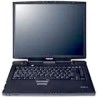Toshiba PS610U-NGYSG7 User Manual - Page 53
If Something Goes Wrong, on If the battery light flashes amber during charging, either
 |
View all Toshiba PS610U-NGYSG7 manuals
Add to My Manuals
Save this manual to your list of manuals |
Page 53 highlights
Getting Started Setting up your computer 53 _ + 2 Plug the AC adapter into the DC-IN on the back of the computer. Connecting the AC adapter to the computer 3 Connect the power cable to a live electrical outlet. If the electrical outlet is live, the system indicator panel's AC power light ( ) glows green. If the main battery is present, the battery light glows: ❖ Amber while the battery is charging ❖ Green when the battery is fully charged If the battery light flashes amber during charging, either the battery pack is malfunctioning, or it is not receiving input from the AC power supply. Disconnect the AC cable and remove the battery pack. See "If Something Goes Wrong" on page 195 for troubleshooting information. DANGER: Damaged power cables can cause fire or electric shock. Never modify, forcibly bend, place heavy objects on top of, or apply heat to the power cable. If the power cable becomes damaged or the plug overheats, discontinue use. There is a risk of electric shock. Never remove the power plug from the outlet with wet hands. Doing so may cause an electric shock.















